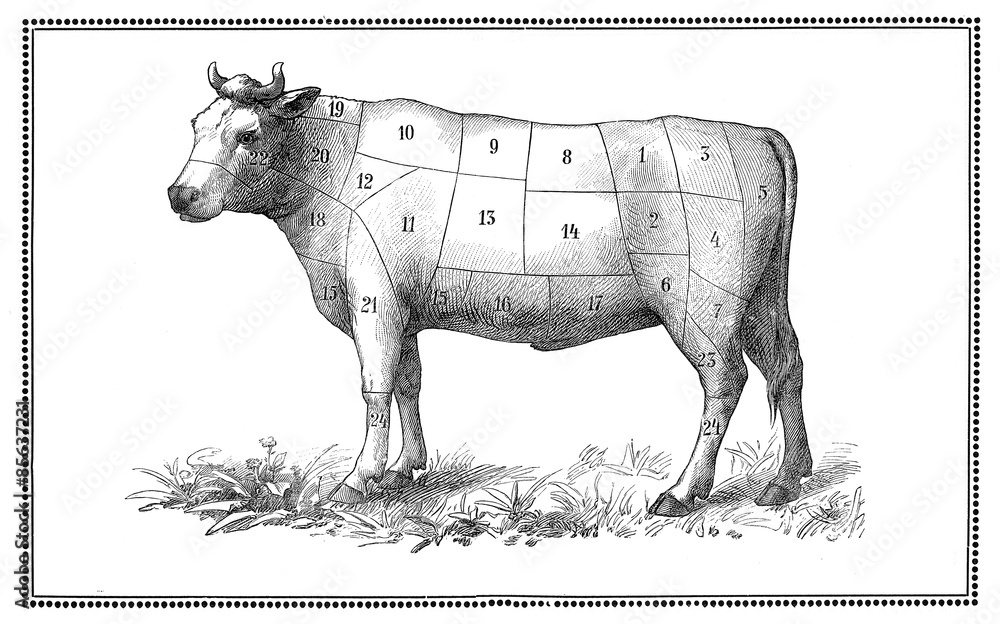
Beef is one of the most versatile meats you can find on the market. Depending on its intended use, different beef cuts should be preferred. This is the reason why we would like to give you a quick overview of the most common cuts.
Categories of the types of beef cuts
Beef cuts are divided into different categories according to their quality, connective tissue and fat content, among other aspects. Generally speaking, those belonging to the “extra” category are characterized by their great tenderness and juiciness, and require a shorter cooking time. On the other end, in the third category, meat is tougher yet extremely flavorful, therefore it is typically used for stews and broths.
“Extra” category
Meat belonging to this group has a high nutritional value and a lot of muscle:
- Ribeye. This cut is very juicy and tender, presenting hardly any fat, and is obtained from the front part of the loin. If it has no bone, it is called entrecote. If it does have a bone, it is called T-bone steak.
- Striploin. This is also a very tender cut with little fat. It is obtained from the back of the loin and is generally used for thick steaks.
- Tenderloin. Obtained from the inside of the lower rib. This meat is juicy, lean and very tender.
First A
Beef in this category is frequently used in the food service industry since it is perfect for frying or grilling:
- Knucle. The part that is close to the rump is great for steaks, while the part that is close to the knee is best used for stewing as it is tougher.
- Eyeround. It has hardly any fat or nerves. It is commonly used for minced and larded meat.
- Top Side. Ideal for grilling or frying, very common in the preparation of escalopes.
- Rump Cap. This piece is very tender and has hardly any fat infiltration. It is obtained from the part near the rump and is perfect for roasts.
- Heart of Rump. It is widely used as fillets for grilling. It is the upper part of the hind legs.
- Flat. As it contains very little fat, it tends to be quite dry. Therefore, it is very frequently used in stews and stuffings.
First B
This category includes pieces from the hindquarter and forequarter. Not as fine as the previous category, they are still quite tender:
- Top Side. It is used in stews, brochettes and fillets. It is characterized by a lot of tendons.
- Shoulder Clod. It is divided into two parts (shoulder clod and chuck roll). From the latter is extracted what is known as ranch steak. It is very juicy and abundant in fat.
- – Shin. It is located in the upper part of the hind legs. Being a very gelatinous meat, it is usually used in stews.
- Chuck Tender. Ideal for baking or stuffing, as it is very tender and juicy. It is located on the front side of the shoulder.
- Chuck Roll. This cut is very versatile, since it can be cooked in many ways. It is obtained from the area that joins the loin and the neck of the animal.
- Tri-tip. It is obtained from the area between the rump and the thick flank. It is much fattier than other pieces in this category.
Beef cuts second category
The different cuts of this group present a fair amount of cartilage, nerves and bones, so they are usually used in stews and casseroles:
- Shank. Meat with a lot of collagen and fiber. It is obtained from the lower part of the legs and is used in the preparation of broths and stews.
- Flank. It is used in stews due to its toughness; it needs long cooking.
- Top blade. This is the part of the shoulder that covers the bone. It is rather fibrous and has quite a lot of flavor.
Third category
These parts have a high presence of bones and ligaments, so they are usually used to prepare broths:
- Nape. Area that joins the neck with the head. This meat has a high presence of tendons and is quite dry.
- Cheek. It is obtained from the muscles that join the chest to the back, and therefore requires very long cooking.
- Tail. A gelatinous, fatty meat with bone, very frequent in stews and broths.
- Brisket. It has a lot of tendons, bones and nerves, so it is used in stews and casseroles.
- Skirt. This part is very gelatinous, has no bones and is very tasty.
- Ribs. It is characterized by a high presence of cartilage in the bones and is a barbecue classic. The skirt stick come from the internal part of the ribs.
In short, there are different types of beef cuts and all of them are very usable. However, cuts such as sirloin, high loin and low loin stand out for their quality and nutritional value. At Rellman Foods we have the best Angus and Hereford beef cuts. If you need a reliable supplier, do not hesitate to contact us.
